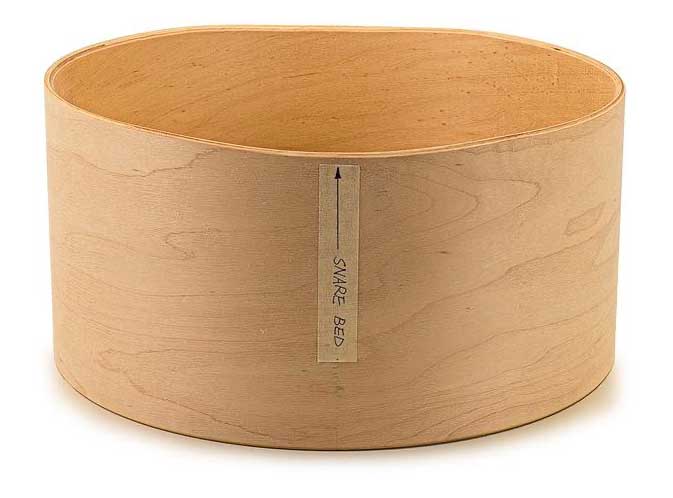What is a snare bed?

A customer once called me after buying a new snare drum. He wasn't too happy as he claimed the bottom of the drum was very uneven. When he placed the drum on a table without the drumhead, light would shine through it. According to him, the drum was crooked and defective. However, the issue was not with the drum itself; it was the snare beds that the customer had encountered without knowing what they were.
If you are not familiar with what snare beds are, why they exist, and what they are used for, then read on.
The term snare bed (let's Anglicize the word) could be translated as "snares resting place" - the place where the snare wires rest against the drum's edge. You will find these snare beds on virtually all snare drums.
If you turn your snare drum upside down, remove the snare wires, the hoops, and the drumhead, then you will be able to see a slight indentation/flattening on the drum's edge where the snare wires were previously located. If not, place the drum (without the hoops and drumhead) on a flat surface - light will shine through it and reveal the snare beds. These slightly curved indentations in the drum's edge are made parallel to the snare system.
What does it do?
In essence, the snare bed ensures that the snare wires lay correctly against the bottom drumhead. One could say that the snare bed creates a gentle curve across the drum that the snare wires rest on - but also evens out, due to the tension from the wires. In fact, the tension from the snare wires evens out the curve, resulting in a snare that - when engaged - operates with the best possible sensitivity and resonance without choking the snare drum.
Size
On some older snare beds, a significant portion of the supporting edge has been cut away. On the Radio King drums from 1950's, it was an area of about 7-8 cm, while Gretsch snares from that period was closer to 13 cm. On a modern snare drum, the snare bed is gradually integrated and can be up to 25 cm long.
Types of drumheads
Stretching out the snare bed was something that began to happen as plastic drumheads became more widespread. These drumheads did not have the same abilities as natural skin to lay along the edge. A modern plastic drumhead cannot reach down into the deep beds, causing the head to wrinkle on either side of the snare bed, making the drum more challenging to tune.
The deep snare beds on older drums were designed for use with calfskin heads that were tensioned around wooden hoops that could more easily follow the contour of the drum's edge (although there were still plenty of wrinkles and bumps to be found on the head near the snare bed).
As modern plastic heads and metal hoops are less flexible, a more gradual snare bed allows for better contact between the head and the bearing edge. A poorly constructed snare bed can cause a lot of problems, such as constant buzzing that one would try to fix by overtightening the snare wires.
How to check your snare bed
It's a good idea to get to the bottom of your problems with your snare bed. You can examine it more closely by flipping the drum over and removing the snare wires, so you can focus on the far edge. Examine the contour of the edge where the snare wires typically rest
The exception
Also, remember that some snare drums don't have a snare bed at all. This may be due to the drum having a special snare mechanism that allows some extra-long snare wires to move parallel up and down from the head instead of being tightened over it. Finally, some manufacturers (e.g. Tama) have recently made snare drums without snare beds.
Life hacks
Tip 1
If you find yourself in a situation with your snare drum where the bottom head curls at the snare wires, here's a little hack: Take a heat gun (or hair dryer) and gently heat around the two areas. This provides a nice and temporary solution (see video).
Tip 2
Another tip if you find that your snare wires are rattling too much: slightly loosen the tension rods on each side of the snare wires (on the bottom head) - but don't overdo it. This can in some cases alleviate the problem.
Tip 3
For a more permanent solution, you can also try using a different type of snare wire that is designed for drums where the snare bed doesn't work optimally. These are often referred to as "pitch" models.
Buy "pitch" snare wires here
If you want to try out a "pitch" snare wire, you can buy it here. If you have an older snare drum or just a snare drum with very little snare bed, it could easily be what makes the difference in getting better response and less rattling.
Want to know more?
This video from "Sounds like a drum" also covers the topic below 👇
Do you want to read other articles?
👉 Who invented the drum set?
👉 My cymbal is spinning - why?
👉 What are cymbals made of?
You can find the other articles on CymbalONE in the menu under OTHER ▶︎ ARTICLES 👍
